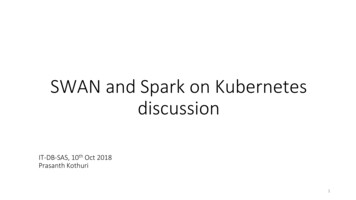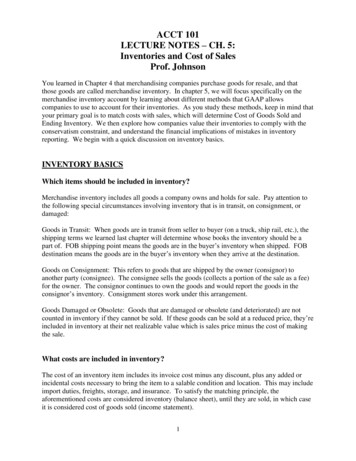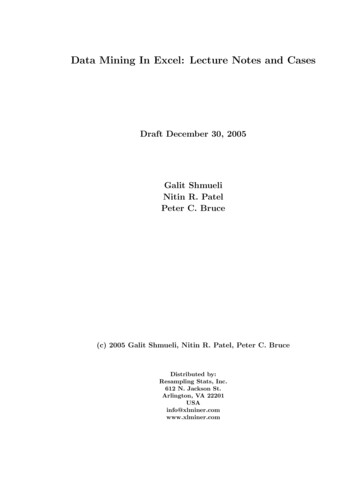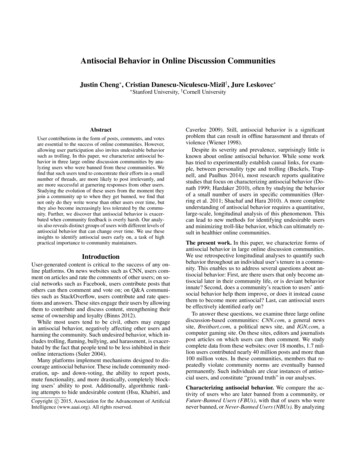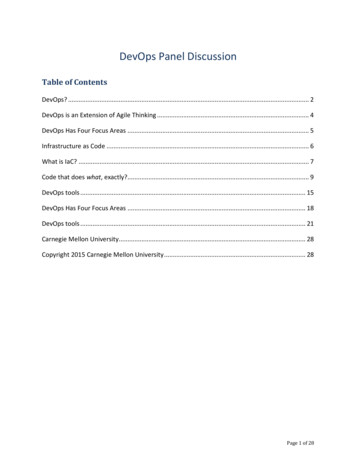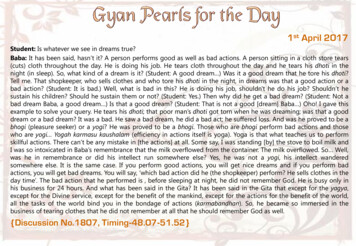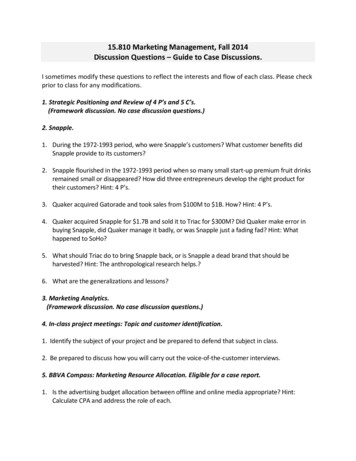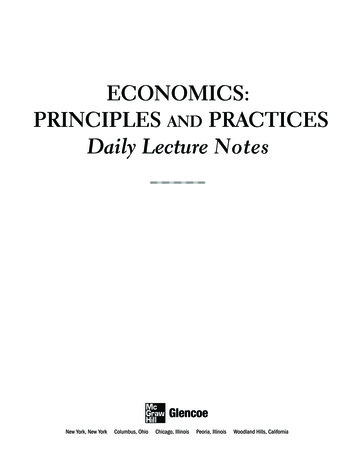
Transcription
ECONOMICS:PRINCIPLES AND PRACTICESDaily Lecture Notes
TO THE TEACHERThe Economics: Principles and Practices Daily Lecture Notes booklet provides detailedoutlines for each section of the student textbook, page number references, and discussionquestions to encourage student participation in classroom activities. Each section beginswith a short, high-interest “Did You Know” anecdote.Copyright by The McGraw-Hill Companies, Inc. All rights reserved. Permission is granted to reproducethe material contained herein on the condition that such material be reproduced only for classroom use;be provided to students, teachers, and families without charge; and be used solely in conjunction withEconomics: Principles and Practices. Any other reproduction, for use or sale, is prohibited without writtenpermission from the publisher.Send all inquiries to:Glencoe/McGraw-Hill8787 Orion PlaceColumbus, OH 43240ISBN 0-07-865047-XPrinted in the United States of America.1 2 3 4 5 6 7 8 9 1004708 07 06 05 04
CONTENTSUNIT 1Chapter 1Fundamental Economic ConceptsWhat Is Economics?1 Scarcity and the Science of Economics . . . . . . . . . . . . . . . . . . . . . . . . . . . . .2 Basic Economic Concepts . . . . . . . . . . . . . . . . . . . . . . . . . . . . . . . . . . . . . . .3 Economic Choices and Decision Making . . . . . . . . . . . . . . . . . . . . . . . . . . .Chapter 2135Economic Systems and Decision Making1 Economic Systems . . . . . . . . . . . . . . . . . . . . . . . . . . . . . . . . . . . . . . . . . . . . 72 Evaluating Economic Performance . . . . . . . . . . . . . . . . . . . . . . . . . . . . . . . . 93 Capitalism and Economic Freedom . . . . . . . . . . . . . . . . . . . . . . . . . . . . . . . 11Chapter 3Business Organizations1 Forms of Business Organization . . . . . . . . . . . . . . . . . . . . . . . . . . . . . . . . . . 132 Business Growth and Expansion . . . . . . . . . . . . . . . . . . . . . . . . . . . . . . . . . . 153 Other Organizations . . . . . . . . . . . . . . . . . . . . . . . . . . . . . . . . . . . . . . . . . . 17UNIT 2Chapter 4MicroeconomicsDemand1 What Is Demand? . . . . . . . . . . . . . . . . . . . . . . . . . . . . . . . . . . . . . . . . . . . . . 192 Factors Affecting Demand . . . . . . . . . . . . . . . . . . . . . . . . . . . . . . . . . . . . . . . 213 Elasticity of Demand. . . . . . . . . . . . . . . . . . . . . . . . . . . . . . . . . . . . . . . . . . . 22Chapter 5Supply1 What Is Supply? . . . . . . . . . . . . . . . . . . . . . . . . . . . . . . . . . . . . . . . . . . . . . . 242 The Theory of Production . . . . . . . . . . . . . . . . . . . . . . . . . . . . . . . . . . . . . . . 263 Cost, Revenue, and Profit Maximization. . . . . . . . . . . . . . . . . . . . . . . . . . . . 28Chapter 6Prices and Decision Making1 Prices as Signals . . . . . . . . . . . . . . . . . . . . . . . . . . . . . . . . . . . . . . . . . . . . . . 302 The Price System at Work . . . . . . . . . . . . . . . . . . . . . . . . . . . . . . . . . . . . . . . 323 Social Goals vs. Market Efficiency . . . . . . . . . . . . . . . . . . . . . . . . . . . . . . . . 34Chapter 7Market Structures1 Competition and Market Structures . . . . . . . . . . . . . . . . . . . . . . . . . . . . . . . 362 Market Failures . . . . . . . . . . . . . . . . . . . . . . . . . . . . . . . . . . . . . . . . . . . . . . 393 The Role of Government . . . . . . . . . . . . . . . . . . . . . . . . . . . . . . . . . . . . . . . . 41Daily Lecture Notesiii
UNIT 3Chapter 8Macroeconomics: InstitutionsEmployment, Labor, and Wages1234Chapter 9The Economics of Taxation. . . . . . . . . . . . . . . . . . . . . . . . . . . . . . . . . . . . . . .The Federal Tax System. . . . . . . . . . . . . . . . . . . . . . . . . . . . . . . . . . . . . . . . . .State and Local Tax Systems . . . . . . . . . . . . . . . . . . . . . . . . . . . . . . . . . . . . .Current Tax Issues. . . . . . . . . . . . . . . . . . . . . . . . . . . . . . . . . . . . . . . . . . . . . .50525456Government Spending1234Chapter 1143454648Sources of Government Revenue1234Chapter 10The Labor Movement . . . . . . . . . . . . . . . . . . . . . . . . . . . . . . . . . . . . . . . . . .Resolving Union and Management Differences . . . . . . . . . . . . . . . . . . . . . .Labor and Wages . . . . . . . . . . . . . . . . . . . . . . . . . . . . . . . . . . . . . . . . . . . . . .Employment Trends and Issues . . . . . . . . . . . . . . . . . . . . . . . . . . . . . . . . . . .The Economics of Government Spending . . . . . . . . . . . . . . . . . . . . . . . . . . . .Federal Government Expenditures . . . . . . . . . . . . . . . . . . . . . . . . . . . . . . . . .State and Local Government Expenditures . . . . . . . . . . . . . . . . . . . . . . . . . .Deficits, Surpluses, and the National Debt . . . . . . . . . . . . . . . . . . . . . . . . . .58606264Money and Banking1 The Evolution of Money . . . . . . . . . . . . . . . . . . . . . . . . . . . . . . . . . . . . . . . . 662 Early Banking and Monetary Standards . . . . . . . . . . . . . . . . . . . . . . . . . . . . 683 The Development of Modern Banking . . . . . . . . . . . . . . . . . . . . . . . . . . . . . . 70Chapter 12Financial Markets1 Savings and the Financial System . . . . . . . . . . . . . . . . . . . . . . . . . . . . . . . . . 732 Investment Strategies and Financial Assets . . . . . . . . . . . . . . . . . . . . . . . . . . 753 Investing in Equities, Futures, and Options . . . . . . . . . . . . . . . . . . . . . . . . . . 78UNIT 4Chapter 13Macroeconomics: PoliciesEconomic Performance1234Chapter 1480828384Economic Instability1234Chapter 15Measuring the Nation’s Output . . . . . . . . . . . . . . . . . . . . . . . . . . . . . . . . . . .GDP and Changes in the Price Level . . . . . . . . . . . . . . . . . . . . . . . . . . . . . .GDP and Population . . . . . . . . . . . . . . . . . . . . . . . . . . . . . . . . . . . . . . . . . . .Economic Growth . . . . . . . . . . . . . . . . . . . . . . . . . . . . . . . . . . . . . . . . . . . . .Business Cycles and Fluctuations . . . . . . . . . . . . . . . . . . . . . . . . . . . . . . . . .Unemployment . . . . . . . . . . . . . . . . . . . . . . . . . . . . . . . . . . . . . . . . . . . . . . . .Inflation . . . . . . . . . . . . . . . . . . . . . . . . . . . . . . . . . . . . . . . . . . . . . . . . . . . . .Poverty and the Distribution of Income . . . . . . . . . . . . . . . . . . . . . . . . . . . . .86889092The Fed and Monetary Policy1 The Federal Reserve System . . . . . . . . . . . . . . . . . . . . . . . . . . . . . . . . . . . . . . 942 Monetary Policy . . . . . . . . . . . . . . . . . . . . . . . . . . . . . . . . . . . . . . . . . . . . . . . 963 Monetary Policy, Banking, and the Economy . . . . . . . . . . . . . . . . . . . . . . . . 98Daily Lecture Notesiv
Chapter 16Achieving Economic Stability1234UNIT 5Chapter 17The Cost of Economic Instability . . . . . . . . . . . . . . . . . . . . . . . . . . . . . . . . . 100Macroeconomic Equilibrium . . . . . . . . . . . . . . . . . . . . . . . . . . . . . . . . . . . . . 101Stabilization Policies . . . . . . . . . . . . . . . . . . . . . . . . . . . . . . . . . . . . . . . . . . . 103Economics and Politics . . . . . . . . . . . . . . . . . . . . . . . . . . . . . . . . . . . . . . . . . 105International and Global EconomicsInternational Trade1 Absolute and Comparative Advantage . . . . . . . . . . . . . . . . . . . . . . . . . . . . . . 1072 Barriers to International Trade . . . . . . . . . . . . . . . . . . . . . . . . . . . . . . . . . . . 1093 Financing and Trade Deficits . . . . . . . . . . . . . . . . . . . . . . . . . . . . . . . . . . . . 111Chapter 18Comparative Economic Systems1234Chapter 19The Spectrum of Economic Systems . . . . . . . . . . . . . . . . . . . . . . . . . . . . . . . 112The Rise and Fall of Communism . . . . . . . . . . . . . . . . . . . . . . . . . . . . . . . . . 114The Transition to Capitalism . . . . . . . . . . . . . . . . . . . . . . . . . . . . . . . . . . . . . 116The Various Faces of Capitalism . . . . . . . . . . . . . . . . . . . . . . . . . . . . . . . . . . 117Developing Countries1 Economic Development . . . . . . . . . . . . . . . . . . . . . . . . . . . . . . . . . . . . . . . . . 1192 A Framework for Development . . . . . . . . . . . . . . . . . . . . . . . . . . . . . . . . . . . . 1213 Financing Economic Development . . . . . . . . . . . . . . . . . . . . . . . . . . . . . . . . 123Chapter 20Global Economic Challenges1 The Global Demand for Resources . . . . . . . . . . . . . . . . . . . . . . . . . . . . . . . . 1252 Economic Incentives and Resources . . . . . . . . . . . . . . . . . . . . . . . . . . . . . . . . 1273 Applying the Economic Way of Thinking . . . . . . . . . . . . . . . . . . . . . . . . . . . . 129Daily Lecture Notesv
1-1D ID YOU KNOW?We witness scarcity with each year’s “hot” new toy. Inspired by hunter President TeddyRoosevelt, Americans coveted the teddy bear in 1906. Cabbage Patch dolls were big duringthe 1980s, as were Tickle Me Elmos in 1996. By 1999 Game Boy’s Pokémon was the ragewith a 10-cent trading card. The most-prized first-edition pocket monsters were in such shortsupply that they commanded from 8 to 182.PAGES 5-6I. The Fundamental Economic ProblemA. Scarcity is the condition where unlimited human wants face limited resources.B. Economics is the study of how people satisfy wants with scarce resources.C. Needs are required for survival; wants are desired for satisfaction.D. Someone has to pay for production costs, so There Is No Such Thing As A Free Lunch(TINSTAAFL). Discussion QuestionWhy do you think scarcity is an issue with the rich as well as the poor? (It is a human traitthat few people, regardless of their economic status, are satisfied with what they have.)PAGES 6-7II. Three Basic QuestionsB. How should we produce it? Society must choose based on its resources.C. For whom should we produce? Society must choose based on its population and otheravailable markets. Discussion QuestionHow might the economic decisions of a mountainous island society differ from those of amountainous landlocked society? (An island society has water resources to consider andlikely a more limited population.)turnDaily Lecture Notes1Copyright by The McGraw-Hill Companies, Inc.A. What must we produce? Society must choose based on its needs.
1-1PAGES 7-9III. The Factors of ProductionA. Factors of production are resources necessary to produce what people want or need.B. Land is the society’s limited natural resources—landforms, minerals, vegetation, animallife, and climate.C. Capital is the means by which something is produced such as money, tools, equipment, machinery, and factories.D. Labor is the workers who apply their efforts, abilities, and skills to production.E. Entrepreneurs are risk-takers who combine the land, labor, and capital into newproducts.F. Production is creating goods and services—the result of land, capital, labor, andentrepreneurs. Discussion QuestionWhy are entrepreneurs an economy’s driving force? (Their abilities to start new businesses andintroduce new products may re-energize a sluggish economy or strengthen a successfuleconomy.)PAGES 9-10IV. The Scope of EconomicsA. Economics deals with the description of economic activity—Gross Domestic Product,unemployment rate, government spending, tax rates, etc.Copyright by The McGraw-Hill Companies, Inc.B. Analysis looks at the “why” and “how” of economic activity—why prices go up anddown, for example, or how taxes affect savings.C. Explanation refers to how economists communicate knowledge of the economy andits activities to the society’s population.D. Prediction refers to how yesterday’s and today’s economic activities advise us ofpotential future activity. Discussion QuestionWhat makes economics a social science? (Economics is a study of human behavior because itlooks at the decisions people make and how they react to those decisions.)endDaily Lecture Notes2
1-2D ID YOU KNOW?The 20 percent of the world’s people who live in the wealthiest nations consume 86 percentof the world’s goods and services. The 20 percent who live in the poorest nations consumejust 1.3 percent.PAGES 12-13I. Goods, Services, and ConsumersA. Goods are items that are economically useful or satisfy an economic want. They aretangible and can be classified as consumer/capital and durable/nondurable.B. Services are work performed for someone and are intangible.C. Consumers use goods and services to satisfy wants and needs. Discussion QuestionWhy do you think the United States has been called a “society of consumption”? (Answerswill vary. Students should support their opinions with examples.)PAGES 13-14II. Value, Utility, and WealthA. Value is worth expressed in dollars and cents. Scarcity by itself is not enough to createvalue. For something to have value, it must also have utility.C. Wealth is the accumulation of goods that are tangible, scarce, useful, and transferableto another person. Wealth does not include services. Discussion QuestionWhy might a wealthy society not have as much economic staying power as another wealthysociety with a highly skilled labor force? (Answers will vary. Students may indicate that wealthis usually based on limited natural resources, whereas labor can produce more goods andservices.)turnDaily Lecture Notes3Copyright by The McGraw-Hill Companies, Inc.B. Utility is a good’s or service’s capacity to provide satisfaction, which varies with theneeds and wants of each person.
1-2PAGE 14III. The Circular Flow of Economic ActivityA. Markets are locations/mechanisms for buyers and sellers to trade. They are classified aslocal, regional, national, global, and cyberspace.B. A factor market is where people earn their incomes. Factor markets center on the fourfactors of production: land, capital, labor, and entrepreneurs.C. A product market is where people use their income to buy from producers. Productmarkets center on goods and services. Discussion QuestionHow are landlords a part of a factor market? (They provide land or property [a factor of production] to consumers in exchange for rent money, which is the landlords’ source of income.)PAGES 15-17IV. Productivity and Economic GrowthA. Productivity is a measure of the amount of output produced by the amount of inputswithin a certain time. Productivity increases with efficient use of scarce resources.B. Specialization and division of labor may improve productivity because they lead tomore proficiency (and greater economic interdependence).C. Investing in human capital improves productivity because when people’s skills,abilities, health, and motivation advance, productivity increases. Discussion QuestionHow may economic interdependence be a strength of an economy? A weakness? (Answerswill vary. Students may indicate that the economy may gain larger, more diverse markets,leading to greater income and productivity. But the economic problems of those additionalmarkets [customers or suppliers] may adversely affect the economy’s production output orcustomer base.)endDaily Lecture Notes4Copyright by The McGraw-Hill Companies, Inc.D. Economic growth depends on high productivity. Yet, an economy’s productivity may beaffected by its interdependence—reliance on others and their reliance on us to providegoods and services.
1-3D ID YOU KNOW?Economists reward their greatest for breakthrough discoveries. The 1999 Nobel Prize forEconomics went to Robert A. Mundell, a Canadian economist at New York’s ColumbiaUniversity, for his career-long work in international currency exchange rates, vital in today’sglobal marketplace. The prize is worth a million dollars in U.S. currency.PAGES 19-20I. Trade-Offs and Opportunity CostA. Trade-offs are the alternative choices people face in making an economic decision. Adecision-making grid lists the advantages and disadvantages of each choice.B. Opportunity cost is the cost of the next best alternative among a person’s choices. Theopportunity cost is the money, time, or resources a person gives up, or sacrifices, tomake his final choice. Discussion QuestionWhy do you think economists believe opportunity cost is an important factor to consider inaddition to monetary cost? (The money, time, or resources given up when one choice is maderather than another are just as important as the monetary cost of the choice that was made.)PAGES 21-22II. Production PossibilitiesB. Identifying possible alternatives allows an economy to examine how it can best put itslimited resources into production.C. Considering different ways to fully employ its resources allows an economy to analyzethe combination of goods and services that leads to maximum output.D. An economy pays a high cost if any of its resources are idle. It cannot produce on itsfrontier and it will fail to reach its full production potential.E. Economic growth made possible by more resources, a larger labor force, or increasedproductivity causes a new frontier for the economy.turnDaily Lecture Notes5Copyright by The McGraw-Hill Companies, Inc.A. The production possibilities frontier diagram illustrates the concept of opportunity cost.It shows the combinations of goods and/or services that can be produced when allproductive resources are used. The line on the graph represents the full potential—thefrontier—when the economy employs all of these productive resources.
1-3 Discussion QuestionHow might economic growth stimulate greater production possibilities? (Answers will vary.Students may indicate that with a larger labor force, more goods and services are created;newly discovered natural resources open up new products and services.)PAGES 23-24III. Thinking Like an EconomistA. Building simple models helps economists analyze or describe actual economicsituations.B. Cost-benefit analysis helps economists evaluate alternatives by looking at each choice’scost and benefit.C. Taking small, incremental steps in implementing an economic decision helps economists test whether the estimated cost of the decision was correct. Discussion QuestionWhat behaviors and personality traits might you observe in the most successful economists?(Answers will vary. Students should support their opinions with a rationale.)PAGES 24-25IV. The Road AheadA. Studying economics will help us know how the economy works on a daily basis.C. The study of economics helps us to become better decision makers.D. The world of economics is complex and dynamic, as is our society. Discussion QuestionWhat single economic goal have you set for yourself as a result of your study of economics?(Answers will vary. Students must indicate an economic goal rather than an educational goal.)endDaily Lecture Notes6Copyright by The McGraw-Hill Companies, Inc.B. It helps us understand a free enterprise economy, where people and privately ownedbusinesses rather than the government make the majority of the economic decisions.
2-1D ID YOU KNOW?In the United States, individuals usually make their own economic decisions. Sometimes,however, the government makes choices that override individual decisions. During World WarII, for example, the government limited the production of such goods as washing machines,refrigerators, and automobiles so that the resources normally used to produce those goodscould instead be used to make armaments and other goods essential to winning the war.PAGES 33-35I. Traditional EconomiesA. In a traditional economy, roles and economic decisions are defined by custom.B. Examples include the central African Mbuti, the Australian Aborigines, and northernCanada’s Inuits.C. The advantages of a traditional economy is that everyone knows which role to playand there is little uncertainty about WHAT, HOW, and FOR WHOM to produce.D. A disadvantage of a traditional economy is the discouragement of new ideas and newways of thinking. This leads to a lower standard of living than in other societies. Discussion QuestionHow woul
UNIT 3 Chapter 8 Employment, Labor, and Wages 1The Labor Movement. . . . . . . . . . . . . . . . . . . . . .




